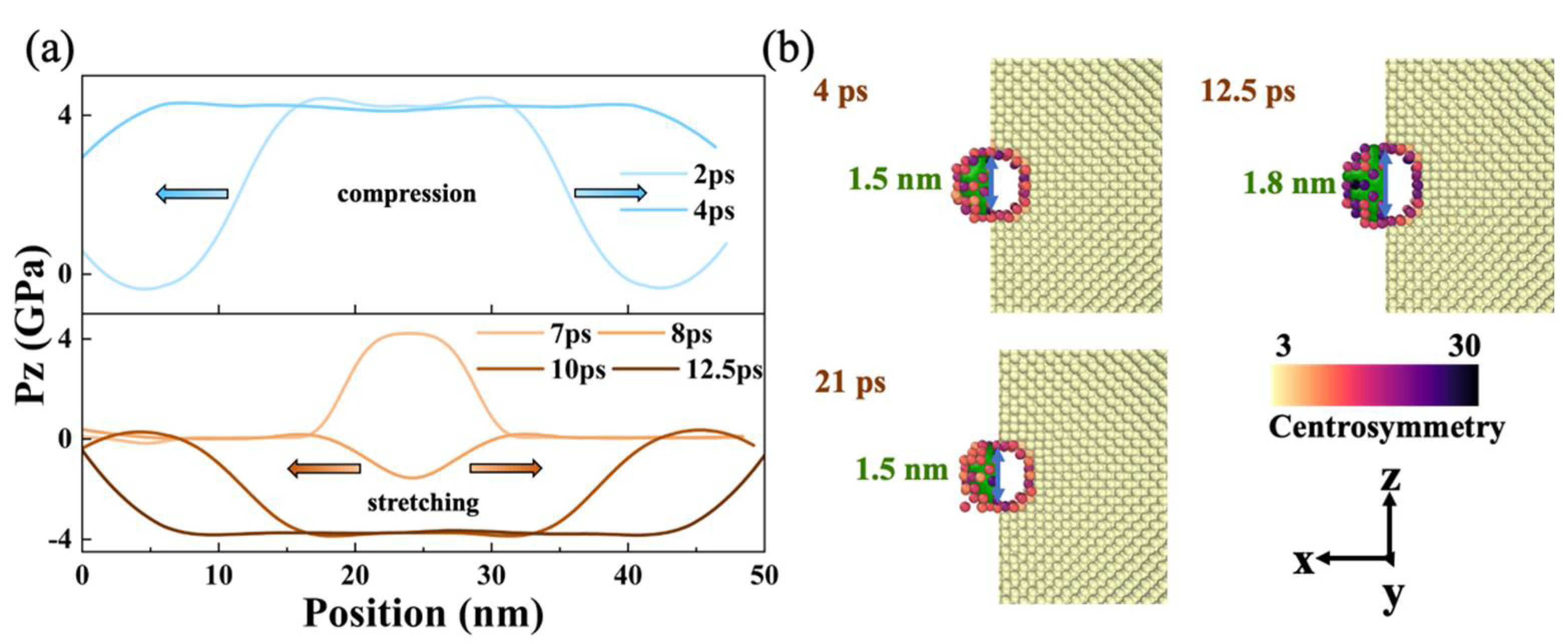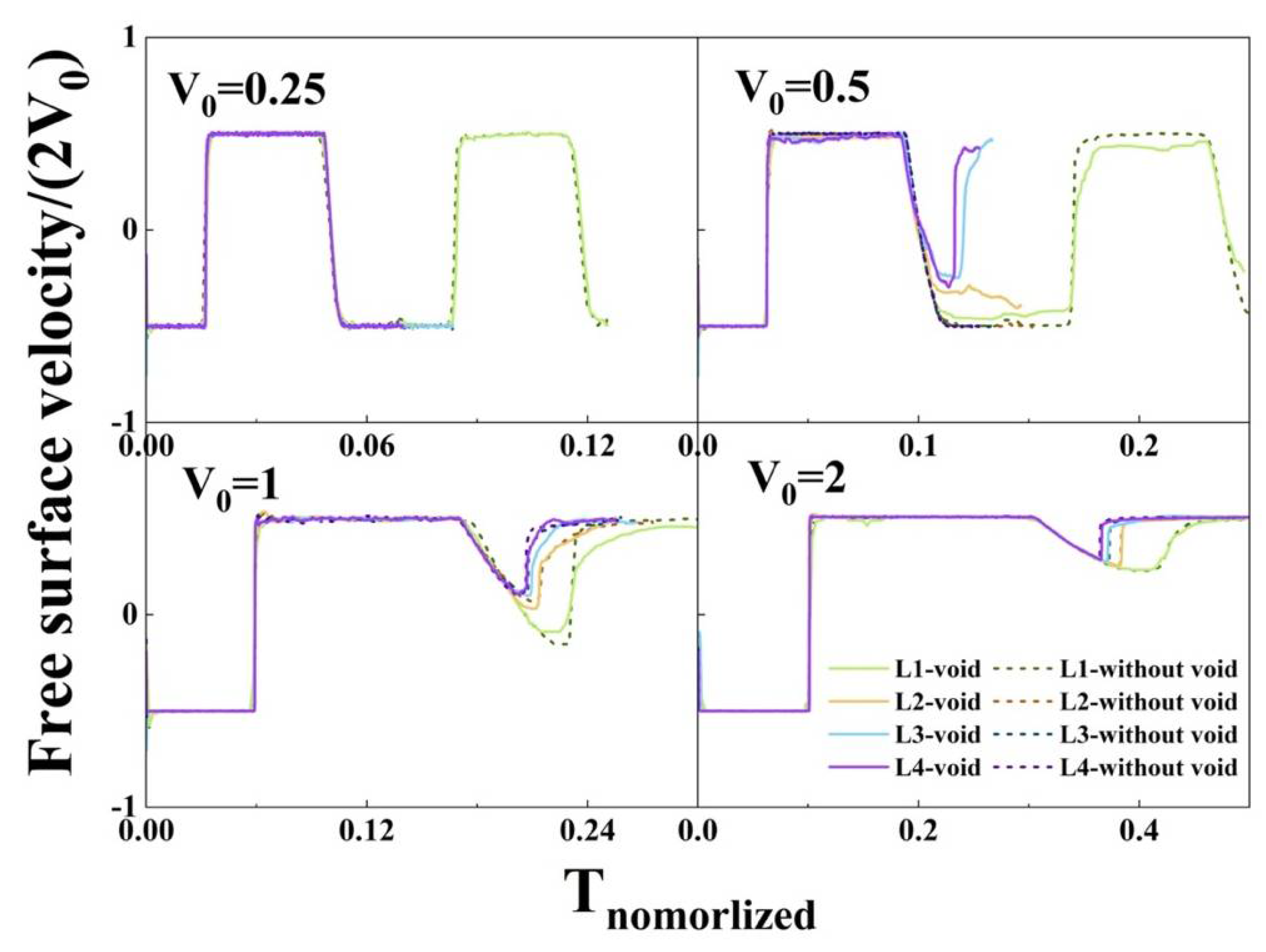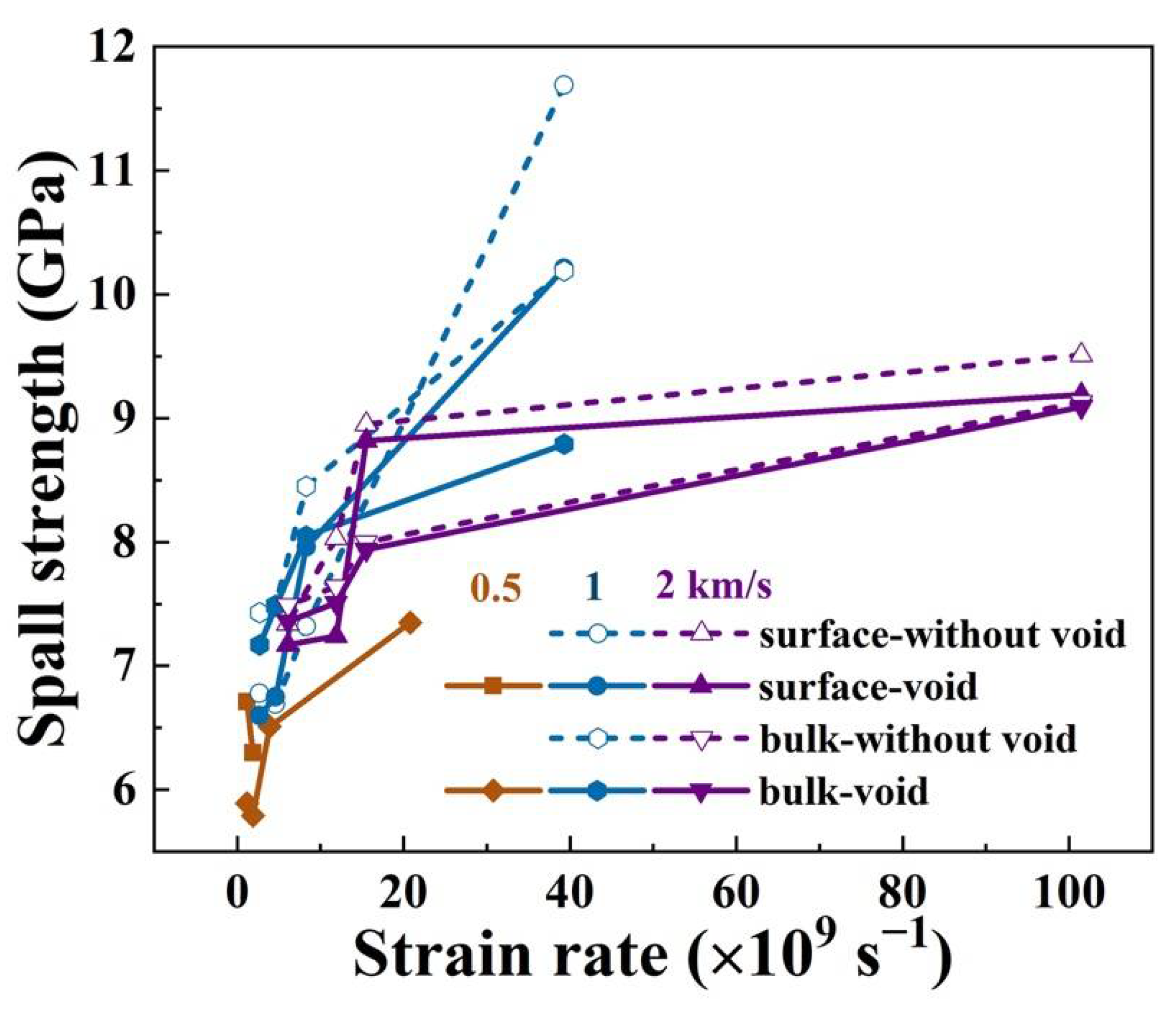Evolution of Preset Void and Damage Characteristics in Aluminum during Shock Compression and Release
Abstract
:1. Introduction
2. Model and Simulation Details
3. Results and Discussion
3.1. Effects of Shock Pressure and Strain Rate of Release on Microstructure Evolution
3.1.1. Void Evolution under Elastic Compression and Release
3.1.2. Limited Growth and Closure of Voids
3.1.3. Typical Spall Damage
3.2. Spall Strength
4. Conclusions
Supplementary Materials
Author Contributions
Funding
Institutional Review Board Statement
Informed Consent Statement
Data Availability Statement
Conflicts of Interest
References
- Rajput, A.; Paul, S.K. Effect of soft and hard inclusions in tensile deformation and damage mechanism of Aluminum: A molecular dynamics study. J. Alloys Compd. 2021, 869, 159213. [Google Scholar] [CrossRef]
- Liu, J.; Fan, X.; Gu, C.; Shi, Y.; Singh, D.J.; Zheng, W. Effect of voids on nanocrystalline gold ultrathin film. Comput. Mater. Sci. 2021, 189, 110255. [Google Scholar] [CrossRef]
- Dong, C.; Lu, X.; Yang, P.; Guo, X.; Ren, J.; Xue, H.; Li, J.; Tang, F.; Li, H.; Ding, Y.; et al. Effects of crystallographic orientation, temperature and void on tensile mechanical properties of Ni-Co single crystal nanopillars. J. Alloys Compd. 2021, 870, 159476. [Google Scholar] [CrossRef]
- Xu, S.; Su, Y.; Chen, D.; Li, L. Plastic deformation of Cu single crystals containing an elliptic cylindrical void. Mater. Lett. 2017, 193, 283–287. [Google Scholar] [CrossRef] [Green Version]
- Xu, C.; Yuan, L.; Shan, D.; Guo, B. {1 0 −1 2} twin boundaries migration accompanied by void in magnesium. Comput. Mater. Sci. 2020, 184, 109857. [Google Scholar] [CrossRef]
- Shao, J.-L.; Wang, P.; He, A.-M.; Duan, S.-Q.; Qin, C.-S. Molecular dynamics study on the failure modes of aluminium under decaying shock loading. J. Appl. Phys. 2013, 113, 163507. [Google Scholar] [CrossRef]
- Peli, S.; Ronchi, A.; Bianchetti, G.; Rossella, F.; Giannetti, C.; Chiari, M.; Pingue, P.; Banfi, F.; Ferrini, G. Optical and mechanical properties of streptavidin-conjugated gold nanospheres through data mining techniques. Sci. Rep. 2020, 10, 16230. [Google Scholar] [CrossRef]
- Ronchi, A.; Sterzi, A.; Gandolfi, M.; Belarouci, A.; Giannetti, C.; Fatti, N.D.; Banfi, F.; Ferrini, G. Discrimination of nano-objects via cluster analysis techniques applied to time-resolved thermo-acoustic microscopy. Ultrasonics 2021, 114, 106403. [Google Scholar] [CrossRef]
- Gandolfi, M.; Peli, S.; Diego, M.; Danesi, S.; Giannetti, C.; Alessandri, I.; Zannier, V.; Demontis, V.; Rocci, M.; Beltram, F.; et al. Ultrafast Photoacoustic Nanometrology of InAs Nanowires Mechanical Properties. J. Phys. Chem. C 2022, 126, 6361–6372. [Google Scholar] [CrossRef]
- Li, Q.; Hoogeboom-Pot, K.; Nardi, D.; Murnane, M.M.; Kapteyn, H.C.; Siemens, M.E.; Anderson, E.H.; Hellwig, O.; Dobisz, E.; Gurney, B.; et al. Generation and control of ultrashort-wavelength two-dimensional surface acoustic waves at nanoscale interfaces. Phys. Rev. B 2012, 85, 195431. [Google Scholar] [CrossRef]
- Righi, G.; Ruestes, C.J.; Stan, C.V.; Ali, S.J.; Rudd, R.E.; Kawasaki, M.; Park, H.-S.; Meyers, M.A. Towards the ultimate strength of iron: Spalling through laser shock. Acta Mater. 2021, 215, 117072. [Google Scholar] [CrossRef]
- Kong, X.F.; Gao, N.; Beyerlein, I.J.; Yao, B.N.; Zheng, S.J.; Ma, X.L.; Legut, D.; Germann, T.C.; Zhang, H.J.; Zhang, R.F. Interface facilitated transformation of voids directly into stacking fault tetrahedra. Acta Mater. 2020, 188, 623–634. [Google Scholar] [CrossRef]
- Liu, H.; Wang, X.M.; Liang, H.; Zhao, Z.N.; Li, L.; Yue, Z.F.; Deng, C.H. The effect of void defect on the evolution mechanisms of dislocations and mechanical properties in nickel-based superalloys by molecular dynamics simulation of real γ/γ′ structures. Int. J. Solids Struct. 2020, 191, 464–472. [Google Scholar] [CrossRef]
- Yang, X.; Zeng, X.; Wang, J.; Wang, J.; Wang, F.; Ding, J. Atomic-scale modeling of the void nucleation, growth, and coalescence in Al at high strain rates. Mech. Mater. 2019, 135, 98–113. [Google Scholar] [CrossRef]
- Li, B.; Mi, C. Effects of void shape and orientation on the elastoplastic properties of spheroidally voided single-crystal and nanotwinned copper. Philos. Mag. 2020, 100, 2291–2319. [Google Scholar] [CrossRef]
- Zhao, L.; Liu, Y. Investigation on void growth and coalescence in single crystal copper under high-strain-rate tensile loading by atomistic simulation. Mech. Mater. 2020, 151, 103615. [Google Scholar] [CrossRef]
- Xu, Q.; Li, W.; Zhou, J.; Yin, Y.; Nan, H.; Feng, X. Molecular dynamics study on void collapse in single crystal hcp-Ti under hydrostatic compression. Comput. Mater. Sci. 2020, 171, 109280. [Google Scholar] [CrossRef]
- Wu, W.-D.; Shao, J.-L. Atomistic study on the dynamic response of the void or helium bubble in aluminum under compression and tension. J. Appl. Phys. 2020, 127, 154902. [Google Scholar] [CrossRef] [Green Version]
- Wang, J.P.; Liang, J.W.; Wen, Z.X.; Yue, Z.F. Atomic simulation of void location effect on the void growth in nickel-based single crystal. Comput. Mater. Sci. 2019, 160, 245–255. [Google Scholar] [CrossRef]
- Wang, L.; Sun, J.; Li, Q.; Li, Z.; Zheng, Y. Coupling effect of twin boundary and void on the mechanical properties of bulk nanotwinned copper: An atomistic simulation. J. Phys. D Appl. Phys. 2018, 52, 055303. [Google Scholar] [CrossRef]
- Plimpton, S. Fast Parallel Algorithms for Short-Range Molecular Dynamics. J. Comput. Phys. 1995, 117, 1–19. [Google Scholar] [CrossRef] [Green Version]
- Zhakhovskii, V.V.; Inogamov, N.A.; Petrov, Y.V.; Ashitkov, S.I.; Nishihara, K. Molecular dynamics simulation of femtosecond ablation and spallation with different interatomic potentials. Appl. Surf. Sci. 2009, 255, 9592–9596. [Google Scholar] [CrossRef]
- Irving, J.H.; Kirkwood, J.G. The Statistical Mechanical Theory of Transport Processes. IV. The Equations of Hydrodynamics. J. Chem. Phys. 1950, 18, 817–829. [Google Scholar] [CrossRef]
- Stukowski, A. Visualization and analysis of atomistic simulation data with OVITO–the Open Visualization Tool. Modell. Simul. Mater. Sci. Eng. 2009, 18, 015012. [Google Scholar] [CrossRef]
- Remington, T.P.; Hahn, E.N.; Zhao, S.; Flanagan, R.; Mertens, J.C.E.; Sabbaghianrad, S.; Langdon, T.G.; Wehrenberg, C.E.; Maddox, B.R.; Swift, D.C.; et al. Spall strength dependence on grain size and strain rate in tantalum. Acta Mater. 2018, 158, 313–329. [Google Scholar] [CrossRef] [Green Version]
- Li, G.; Wang, Y.; Xiang, M.; Liao, Y.; Wang, K.; Chen, J. Shock response of nanoporous magnesium by molecular dynamics simulations. Int. J. Mech. Sci. 2018, 141, 143–156. [Google Scholar] [CrossRef]
- Fan, H.; Wang, Q.; El-Awady, J.A.; Raabe, D.; Zaiser, M. Strain rate dependency of dislocation plasticity. Nat. Commun. 2021, 12, 1845. [Google Scholar] [CrossRef]












| Sample Size | Impact Velocity (km/s) | |||
|---|---|---|---|---|
| 0.25 | 0.5 | 1 | 2 | |
| L1 | 10.02 | 20.78 | 39.32 | 101.51 |
| L2 | 1.86 | 3.85 | 8.34 | 15.50 |
| L3 | 1.13 | 1.92 | 4.57 | 11.98 |
| L4 | 0.60 | 1.23 | 2.70 | 6.04 |
Publisher’s Note: MDPI stays neutral with regard to jurisdictional claims in published maps and institutional affiliations. |
© 2022 by the authors. Licensee MDPI, Basel, Switzerland. This article is an open access article distributed under the terms and conditions of the Creative Commons Attribution (CC BY) license (https://creativecommons.org/licenses/by/4.0/).
Share and Cite
Wan, Y.-T.; Shao, J.-L.; Yu, G.-Z.; Guo, E.-F.; Shu, H.; Huang, X.-G. Evolution of Preset Void and Damage Characteristics in Aluminum during Shock Compression and Release. Nanomaterials 2022, 12, 1853. https://doi.org/10.3390/nano12111853
Wan Y-T, Shao J-L, Yu G-Z, Guo E-F, Shu H, Huang X-G. Evolution of Preset Void and Damage Characteristics in Aluminum during Shock Compression and Release. Nanomaterials. 2022; 12(11):1853. https://doi.org/10.3390/nano12111853
Chicago/Turabian StyleWan, Ya-Ting, Jian-Li Shao, Guang-Ze Yu, Er-Fu Guo, Hua Shu, and Xiu-Guang Huang. 2022. "Evolution of Preset Void and Damage Characteristics in Aluminum during Shock Compression and Release" Nanomaterials 12, no. 11: 1853. https://doi.org/10.3390/nano12111853






